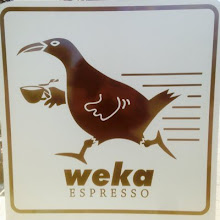
It's that's time again:
Wellington on a Plate has kicked off. Seventeen days of food, fun and more food. Wellington is a great place for foodies to be in August each year. I have four festival events booked this year and hope to squeeze in a lunch or two along the way.
First up was a practical lesson.
The Clareville Bakery north of Carterton is renown for its artisan bread and pies. They're offering two classes for Welly on a Plate this year: a
bread masterclass and the
perfect pastry class. We packed up our aprons and headed over the Rimutaka hill for a hands-on pastry masterclass with Mike and Rose Kloeg, owners of The Clareville Bakery.
The class was a mix of demonstrations and hands-on practice. We learned about making puff pastry, Danish pastry (similar to puff but one less fold), choux pastry and sweet pastry. A
French pastry class five years ago gave me a glimpse of what's involved in the process, which is too labour intensive for me to repeat at home, but I was keen to revisit the techniques and pick up some more tips.
Danish pastry
We practised working with Danish pastry. Like puff pastry, the art of Danish pastry involves more rolling, resting and patience than a three hour class allows. However, our already-prepared 10 x 10 cm squares meant we could have fun with shaping and actually have something to take home at the end of the evening.
We learned three techniques for folding and filling pastry squares. I was quick to master the first one: a square with an indent in the middle for custard and fruit. The second technique involved creating a pinwheel by cutting diagonal slits to corners of the square and indenting the centre.
 |
Danish pinwheel
Indent the centre and cut from the edges |
Next, each corner was folded from below the slit into the centre to create a flower shape and secured by pressing down the centre. The centre is then filled with crème pâtissière and topped with fruit before baking.
 |
| Fold corners into the centre to create a pinwheel |
The third technique was creating a classic pocket. Fold corners to the centre and indent to secure.
 |
| Danish pocket - first fold |
Repeat with the opposite two corners to create a square pocket. Again, fill with
crème pâtissière and top with fruit before baking.
 |
| Fold in half again to create a Danish pocket |
Choux pastry
I enjoy making choux pastry; it's one of my baking success stories that sees éclairs and profiteroles frequently on my dinner party menu. However, I'd never made a choux pastry swan before. Mike's recipe includes milk for texture and colour. He showed us how to use a large star nozzle to pipe swan bodies.
 |
| Piped swan bodies |
You can also pipe profiteroles using the same star nozzle.
 |
| Profiteroles |
Finally, add a small round nozzle to the end to make the swan necks.
 |
Piped swan necks
Spot the intruder | |
To assemble, cut the bodies horizontally, then slice the top half of the body vertically. Pipe crème pâtissière on the bottom, arrange the wings and neck and dust with icing sugar.
 |
| So elegant! |
Mike and Rose joined us for a wine and cheese break. It was great to hear about Clareville Bakery's story from when they first started in 2013 to get to where they are now - and the journey is continuing.
 |
| Perfect cheese platter with house made crackers |
Then it was back to the kitchen to pack up our goodies. Here is everything we took home: three styles of Danish pastry, caramelised onion and potato galettes, profiteroles, choux pastry swans and sweet fruit tarts.
 |
| Finish products |
A huge thank you to Mike and Rose for their hospitality and expertise. I learned some new techniques and was reminded of other tips I'd forgotten. I doubt I'll be making puff or Danish pastry any time soon but I'm keen to give sweet fruit tarts a try at home.
 It's that's time again: Wellington on a Plate has kicked off. Seventeen days of food, fun and more food. Wellington is a great place for foodies to be in August each year. I have four festival events booked this year and hope to squeeze in a lunch or two along the way.
It's that's time again: Wellington on a Plate has kicked off. Seventeen days of food, fun and more food. Wellington is a great place for foodies to be in August each year. I have four festival events booked this year and hope to squeeze in a lunch or two along the way.











No comments:
Post a Comment